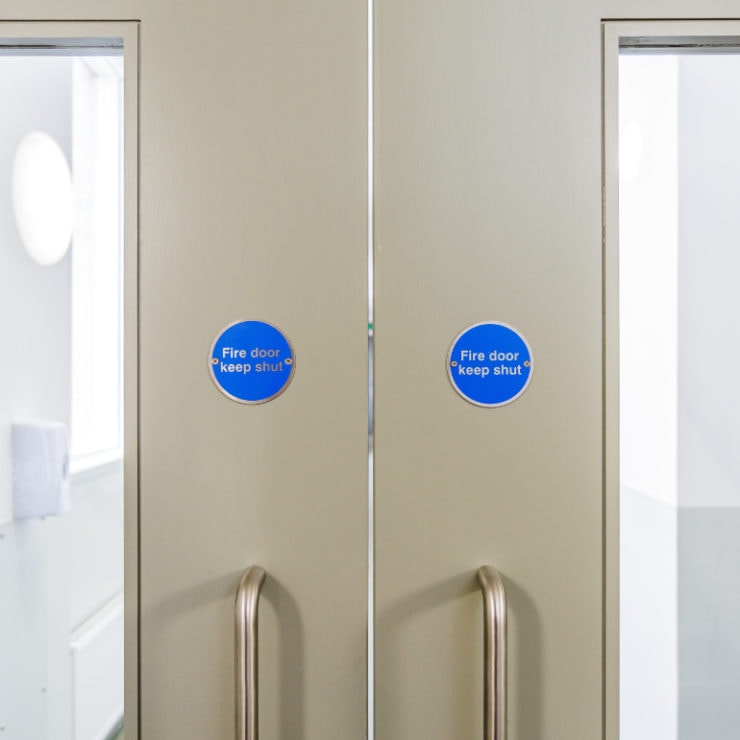Your fire doors put up with a lot. They’re not just an essential part of your passive fire protection (PFP) strategy, they do the daily job of a conventional door too, so they can be subject to their fair share of knocks, wear, and tear. And this can take its toll on their ability to function as effective fire doors should the need arise.
This is why fire door inspections, and the fire door maintenance arising from them, are vital, and need to be carried out regularly by qualified, accredited specialists. If they’re not, there is not only a heightened risk that fire, once started, will spread, but that the person responsible for fire safety in your building will be in breach of their duties under UK regulations.
But what should the inspection process look like, how often should it happen, and where can you get help to ensure your inspections are thorough and legally compliant?
How frequently should fire doors be inspected?
British Standard BS 9999 recommends fire doors should be inspected at least every six months to ensure they are both fully functional and compliant.
However, there are three important additional considerations to be aware of here.
Firstly, if the fire doors in question are in a newly occupied building, it is better to inspect them more regularly than this during the first year of use, as the doors’ physical characteristics can change as they acclimatise to their new environment.
Secondly, fire doors in high-traffic buildings or zones of buildings are more susceptible to damage and should ideally be inspected monthly by suitably trained staff for basic issues such as cracks, loose fittings, and correct closure, in between the more rigorous external inspections.
Thirdly, passing an inspection does not mean the doors will remain safe and compliant for the next six months come what may. In fact, you have a duty of care to ensure the doors are properly maintained over this period.
And a word of warning here: not just anybody can carry out that maintenance. As we explained in a previous post on Why Anyone Can’t Just Fit a Fire Door, perfectly compliant fire doors can become instantly non-compliant if they are repaired or maintained by someone who is not qualified and competent to do so.
A compliant fire door can even forfeit its compliance if any fittings, fixtures, and features added to it during the maintenance process are themselves not compliantly fire-rated.

What does a fire door inspection involve?
A fire door inspection covers a number of different criteria, and can be a complex and time-consuming undertaking when many fire doors are involved, and it does not address fire safety issues in other areas of PFP, so it is often more cost-effective to enlist the help of a specialist in fire protection surveys to cover off both fire doors and the wider PFP picture.
Amongst other things, an inspector will examine:
- Door frames – Damage or major defects in either the door leaves or frames will be carefully searched for and identified, and, if found, a recommendation will be made to replace these structures using an accredited supplier and certified materials.
- Glazing – Cracked or broken glass vision panels compromise the fire door’s ability to compartmentalise fire and toxic gases and stop them spreading, so if faults of this nature are found, the inspector will recommend the glazing is replaced immediately.
- Closing and opening devices – The inspection must be able to establish that the fire doors can open and close correctly, so faulty opening and closing devices will be a fail – as will worn ironmongery that could impair the door’s opening and closing, including hinges and latches.
- Certification labelling – If the certification label, usually located on the top of the door or below the bottom hinge, is damaged, has been painted over, or is missing, the inspector will consider the fire door’s certification invalid, and a suitable replacement door must be sought and installed.
The need for replacement doors and maintenance that often arises from these inspections can add significantly to the post-inspection workload, so once again it can be a more cost-effective decision to involve an external expert in these phases.
Equally, ad-hoc fire door maintenance needs that come to light during everyday use or basic internal inspections must still be fulfilled by qualified and competent parties, and here, again, external experts can be useful in lightening the workload on the building’s responsible person.
Where can I get advice and help for fire door inspections?
Recent tragic events have jolted the government into greater scrutiny of fire protection measures in both commercial and residential buildings.
At the same time, publicly disclosed shortcomings in relation to fire doors specifically – in the most recent survey, 76% of fire doors in the UK failed their inspections in 2019, and 30% were condemned due to poor installation – are turning up the heat on building owners and managers to ensure their fire doors are (and stay) compliant.
Ensure your fire doors are regularly inspected and properly maintained to meet UK regulations and protect your building’s occupants. Our certified fire door specialists provide thorough inspections and expert maintenance to keep your fire doors functioning as they should.
📧 Email us at hello@commercialfireprotection.co.uk
📞 Call us at 08000590113
Or fill out our online contact form to schedule an inspection today!



